ACR’s
All the above solutions suffer from the same problem, they fail to protect the van or host vehicles electrical system. Once, tied together there is no way for these solutions to know the house system may be overloading the vehicles electrical system. Depending on your house current needs while driving, depth of discharge of your battery and alternator output the current draw may drop the voltage too low for some sensitive equipment.
My rig has the Starcool III Air-conditioning option, if am running that with the blower on high, my computer infotainment system, refrigerator, and trying to charge a battery from 50% DOD, my alternator will not supply enough amps at idle. Since the current draw doesn’t change the result will be a drop-in voltage from the alternator. Can it be managed yes, I could get a bigger alternator, turn down the air-conditioning blower or disconnect when going to idle and in this condition.
While I am not sure of the date Sure Power developed the “separator” I know that my rig was built in May of 2004 by Sportsmobile, and it had one of the first Sure Power Separators they had every installed. The “separator” brought new control to the basic solenoid. Now instead of a switch or hot circuit in “run”, the solenoid was connected by electronics monitoring the batteries. Now they could compare the voltage to set point they determined, if the voltage was above that setpoint they connected the two system together with a solenoid. They had another setpoint that they would force a disconnect if the voltage fell below that voltage. Now we had a system that could protect against overloading the vehicles charging system automatically.
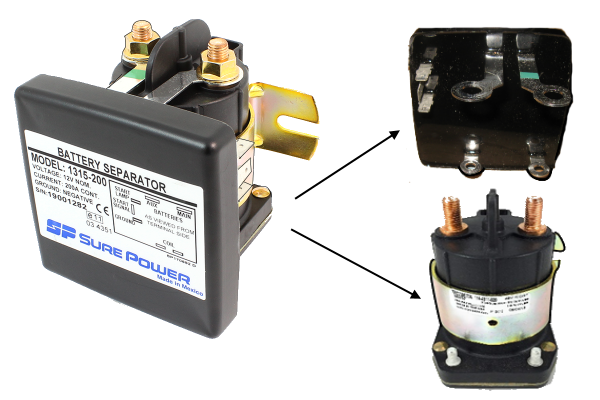
Specifications
• Normal Input Voltage ----------- 9 -16 V
• Minimum Input Voltage --------- 8.5 V
• Contact life ---------------------- 50,000 Cycles
• Connect Voltage ----------------- 13.2 V @ 25°C, See note.
• Disconnect Voltage -------------- 12.8 V @ 25°C, See note.
• Quiescent Current --------------- 10- 13 mA
• Relay drive current -------------- 1.5 A
• Connect debounce ---------------4.4 s
• Disconnect debounce ------------7.2 s
The Sure Power unit took a control unit and married it with an existing Trombetta solenoid. They have both unidirectional and bidirectional units; they also have smaller amp rated units.
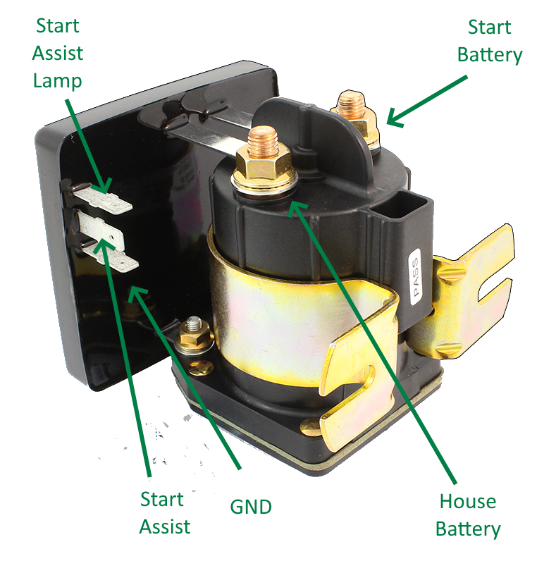
The power derived for unit comes from the house battery terminal, so we need to supply a ground connection which comes from the ground tab on the control module. The control module also attaches to the solenoid control post. All we need to connect is the two batteries systems and a ground. It is always good to put a fuse on the ground connection; this will allow some protection to the control unit. The main purpose of the control unit is to monitor the voltage levels of each battery.
The 1315-200 will activate only when either the start(main) or house(aux) battery system
exceeds 13.2 volts. The 1314-200 will activate only when the start(main) battery system exceeds 13.2 volts. If the drain on the charging system by the auxiliary or main battery bank reduces the system voltage below 12.8 volts, the “Separator” will disconnect the battery banks from each other, thus protecting the respective battery banks from excessive drain. This means if you had a heavy load and were at idle, instead of the voltage on the Van electrical system dropping below 12.8 volts, the separator will disconnect the systems. Once the voltage again exceeds 13.2 volts the separator will connect.
The Sure Power line also supports a feature they call start assist. While intentions may have been good, I generally view the start assist feature as a negative, and don’t recommend it to be hooked up to the “start circuit” but instead to momentary switch. The unit supports up 50,000 switching cycles.
Many people started having issues with Sure Power unit, and by then Blue Sea Systems® had come out with their line of ACR or Automatic Control Relay. The Blue Sea Systems® ACR’s brought the same concepts of the Sure Power unit. Monitor the voltage and engage a relay to connect the two battery systems. The 7620 and 7622 are similar except for a manual knob provided on the 7622.
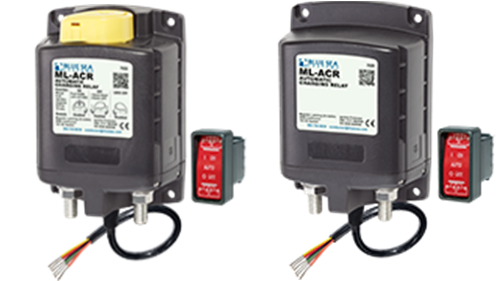
Specifications
- Manual Control ------------------------- Yes
- Nominal Voltage ------------------------ 12V DC
- Cranking Rating (10 sec.) --------------2,500A DC
- Cranking Rating (1 min.) ---------------1,100A DC
- Intermittent Rating (5 min.) ------------700A DC
- Continuous Rating -----------------------500A DC
Amperage Operating Current
- continuous@ 25°C nominal VDC -------< 13mA
Amperage Operating Current
- when changing state --------------------< 7.0A DC
- Switching Cycles -------------------------100,000
- Coil Function ---------------------------- Magnetic Latching, Auto-Releasing
- Control Switch Included ---------------- 2146 SPDT ON-OFF-ON
- Mounting ---------------------------------#10 or M5
- Terminal Stud Size ---------------------- 3/8"-16 (M10)
- Terminal Stud Length ------------------- 7/8" (22 mm)
- Maximum Terminal Stud ---------------- Torque 140 in-lb (15.8 Nm)
- Cable Size to Meet Ratings -------------- 4/0 AWG (120 mm²) x 2
Relay Contact Position:
- Combine (30 sec.) ----------------------13.5V
- Combine (90 sec.) ----------------------13.0V
- Open Low (10 sec.)----------------------12.35V
- Open Low (30 sec.)----------------------12.75V
- Open High--------------------------------16.2V
While the current capacity of the ACR is larger than the SurePower units, 500-amp capability. One of the key differences is that the solenoid is a magnetic latch relay. This means that no current is being used to keep the ACR open or closed. This can important if you use solar to charge both house and start batteries, no power loss to keep solenoid active. The unit also doubles the switching cycle life to 100,000.
The 7620 & 7622 both come with a remote switch (although sportsmobile does not install them). The switch can give you manual operation and more importantly give you indication if the unit is active or not. Plus, the device will give you some diagnostic error codes.
The installation is about as simple as the Sure Power, connect the house battery and start battery, and the ground wire.
Surepower actually came out with a latching relay-based unit of their own, the Sure Power 3104 Battery Interconnect Controller, 300A
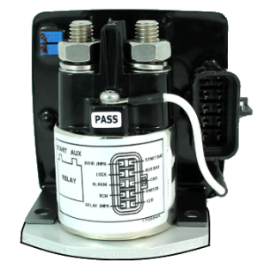
Specifications
- Normal Input Voltage ----------------- 9-16 V
- Minimum Input Voltage --------------- 8.5 9 V
- Under voltage Shutdown -------------- 8.3- 9 V
- Contact voltage drop ------------------ 0.15 V 300A resistive load.
- Contact life ----------------------------- 50,000 Cycles 300A resistive load.
- Connect Voltage:----------------------- 13.0 13.2 13.5 V
- Disconnect Voltage:-------------------- 12.5 12.7 13.0 V
The 3104 uses a 300A latching relay, that supports 100,000 switching cycles. It also comes as a very configurable unit, it supports both unidirectional, bidirectional, or can be used as a LVD or low voltage disconnect. Although the Sure Power 3104 has been available since 2011, it does not seem to have caught on. I suspect in some ways that has to do with their price.
Last, but not least Trombetta, makes their own separator now, the SBS-200-003,
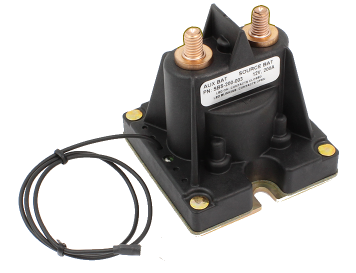
a 200A latching relay. While at this time they say you can get it in either bidirectional or unidirectional, I have found no part number difference to validate that. The Trombetta unit is an integrated unit, it supports up to 50,000 switching cycles.
All these units work pretty much on the same principle, monitor the voltages of the batteries and connect and disconnect at determined setpoints. So, they should be able to disconnect if your overall load was too high and the alternator could not keep up with the load. You may have seen one of the common specifications I have listed is switching cycles. This is because this is also a common area of failure. While some units have twice the switch cycles listed, the problem isn’t quite as simple as that. That specification is usually made with high current loads intended. In fact, a high current relay needs high current to keep the contacts clean, there is generally a minimum wetting current needed to keep the contacts from building up resistance. This is usually the number one failure of all of these units, the added resistance will rob you of available power and generate excessive heat in the units. The internal contacts of the Blue Sea Systems® 762X series can be cleaned in the field if necessary.
“Solid State” or FET based units
So, if the relay contact points can be prone to problems, why not get rid of them. Well there are some that do.
The Blue Sea Systems® 7611 “Batterylink”
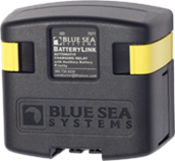
Specifications
- Continuous Rating ---------------------------- 120A
- Intermittent Rating (5 min.)------------------ 210A
- Maximum Cable Size -------------------------- 1/0 AWG
- Operating Current (combine) ----------------- 175mA
- Operating Current (open) --------------------- 15mA
- Terminal Stud Size ---------------------------- 3/8"-16 (M10)
- Maximum Torque ------------------------------ 140 in-lb
- Weight ------------------------------------------1.75 lb (0.79 kg)
Relay Contact Position (12VDC )[/LIST][*] Combine (30 sec.) -----------------------------13.6VDC [*] Combine (2 min.) ------------------------------13.0VDC [*] Open Low (30 sec.) ----------------------------12.75VDC [*] Over Voltage Lockout --------------------------16.0VDC [/LIST]Auxiliary Battery Priority Optional Feature[/LIST][*] Open Low (30 sec.) ----------------------------12.25V DC[/LIST]
or 7610 “SI-Series” are commonly used to fill that need.

Specifications
- Continuous Rating ---------------------- 120A
- Intermittent Rating (5 min.)------------210A
- Maximum Cable Size ------------------- 1/0 AWG
- Operating Current (combine)----------- 175mA
- Operating Current (open)---------------15mA
- Terminal Stud Size ----------------------3/8"-16 (M10)
- Terminal Stud Torque -------------------140 in-lbs (15.8 Nm)
Relay Contact Position
- Combine (30 sec.) ----------------------13.6V DC
- Combine (2 min.) -----------------------13.0V DC
- Open Low (10 sec.) ---------------------12.35V DC
- Open Low (30 sec.) ---------------------12.75V DC
- Over Voltage Lockout -------------------16.0V DC --
- Under Voltage Lockout ------------------9.5V DC
- Under Voltage Reset --------------------10.0V DC
As we can see the units look identical but have some small differences. The 7611 does not have low voltage lock out and does not support start isolate. It does have an aux battery priority mode that changes the disconnect voltage to 12.25 from 12.75. The 7610 does have a low voltage lock out and supports start isolation. Both units are bidirectional.
There is also another unit from Blue Sea, the 7615
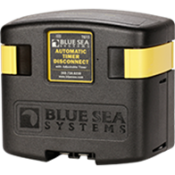
Specifications
- Nominal Voltage ------------------------------- 12V DC
- Input Voltage Range -------------------------- 9.5–16V
- Continuous Rating ----------------------------- 120A
- Intermittent Rating----------------------------- 5 min. 210A
- (Combine) Amperage Operating Current------175mA
- (Open) Amperage Operating Current----------4mA
- Cable Size to Meet Current Ratings------------1/0 AWG (50mm²)
- Maximum Cable Size ---------------------------1/0 AWG (50mm²)
- Terminal Stud Size -----------------------------3/8"-16 (M10)
- Terminal Stud Torque --------------------------140 in-lb (15.82 Nm)
- Time Range -------------------------------------15 Minutes – 4 Hours
Charge Sense ON
- Connected (3 sec) ------------------------------13.0V or greater
- Timing (10 sec)--------------------------------- 12.75V or lower
Low Voltage
- Disconnected (10 sec)--------------------------Battery Voltage <
Over Voltage
- Disconnected(5 sec)---------------------------- 16.0V or greater
The 7615 or ATD Automatic Timer Disconnect is a multi configurable unit, it can be configured a
Timer Disconnect
• 12V signal triggers relay to connect battery power to devices. When signal is removed the timer is activated and will disconnect devices after a preset time
• Timer ranges from 15 minutes to 4 hours
Low Voltage Disconnect
• 12V signal triggers relay to connect battery power to devices.
• After 12V signal is removed, device senses low battery voltage and automatically disconnects devices.
• Low voltage setting can be used in conjunction with Timer Disconnect. Low voltage will disconnect devices prior to preset time to preserve battery power
Automatic Charging Relay
• Automatically combines two batteries when charging and isolates them when discharging.
• Single side sensing design only monitors the voltage of the start battery
• Ideal for auxiliary batteries that are AGM or significantly larger than the start battery
Solenoid
• 12V signal will connect or disconnect relay without any time delay
This unit will operate as a unidirectional ACR, the connect voltage is 13.0 V for (3 sec) and disconnect voltage is 12.75 V. The unit can still be used as a solenoid switch in this configuration also.
And if you need more power, you can look at Perfect Switch, they also have a programmable relay.
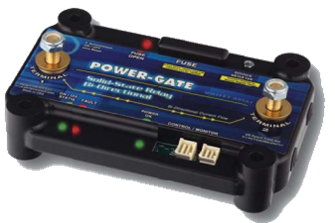
As with the PerfectSwicth isolator can be purchase in 50 to 600 amps versions (50-amp increments). They have standard programable solutions in both uni and bidirectional, and for that matter could do custom programming.
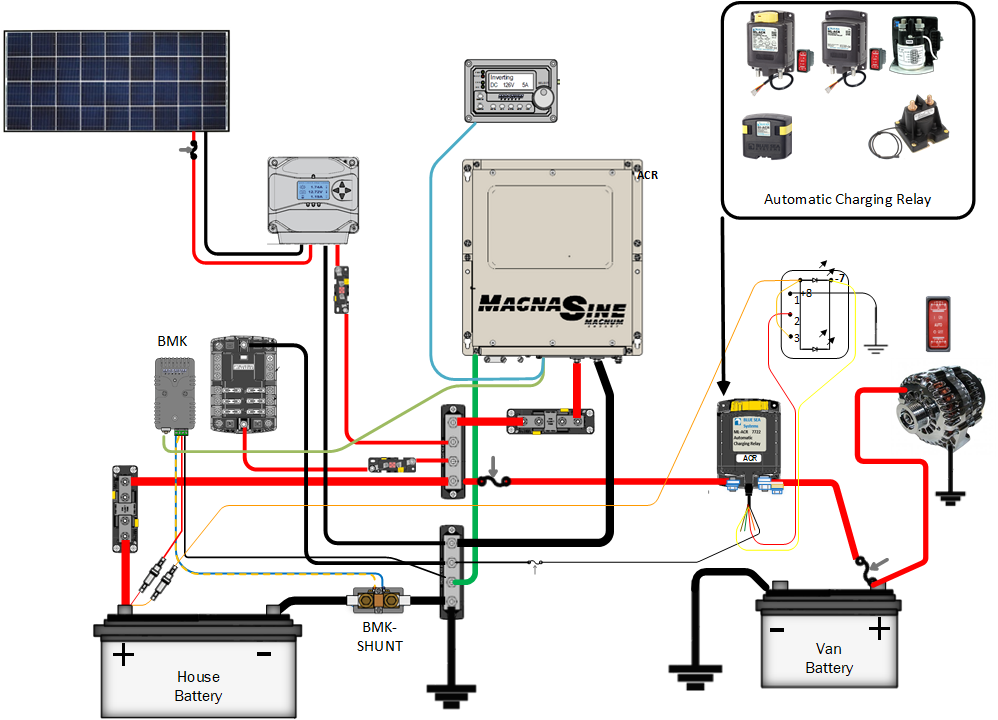 Choosing an ACR
Choosing an ACR
While all ACR’s or smart relays all seem to do the same things, how does one determine what to purchase? The first thing at a minimum is that the capacity of the ACR should match the output of the alternator. After that it comes down to features, so let’s go over the common features.
Combine Voltage
These units have some voltage level and time-based unit to combine the two systems together, this is a voltage level that is usually obtainable some form of a charging unit, be it alternator, shore power or solar.
Disconnect Voltage
Similarly, they have some voltage level and time-based unit to disconnect the two systems, this voltage level is usually the resting voltage of fully charged battery.
Undervoltage lockout
This is a voltage level (usually 9.6 V) that will make sure the two systems are disconnected and remain locked out until the voltage goes above this setting. The main reason for this feature is to protect the existing charging systems. Many alternators and shore-chargers are not designed to charge a dead battery. This feature has been known to catch some owners off guard. This means if you accidently drain your house battery, you can not rely the alternator to recharge. This could be worse if your shore charging option, also has a low voltage lockout.
If concerned about this feature, make sure you have the ability to override this feature. The Blue Sea System® 7622 is the same as the 7620 except it has the “manual control override knob”.
Overvoltage lockout
This is a voltage level (usually above 16 V) that will disconnect the two system, and again keep them disconnected. This is again to protect your systems.
Start isolate
This is a usually found on the Blue Sea Systems® products, by connecting this circuit to the start circuit of the vehicle, we will disconnect the two systems during starting.
Start Assist
This is the opposite of start isolate, and I will separate this into two sections
Automatic Start Assist
The start assist circuit is tied to the “start circuit” on the key switch. This will connect the two battery systems as you start the vehicle. In the authors opinion this is a bad option, this will mask a starting battery going bad, until it is usually to late. This is how Sportsmobile hooked up the original Sure Power units.
Remote Start Assist
The start assists circuit or control wire (7620/7622) is tied to a switch. In many cases this can be a momentary switch that while pushed allow the house battery to assist in starting. If using the (7620/7622) the remote switch can be turned on to implement start assist feature.
Indicator
This is usually a low side signal that is used to show that the unit is combined or not. Some units use it for diagnostic blink codes. While the (7620/7622) have LED’s in the remote switch, this line could be used with just a standard LED indicator.
Bidirectional
This refers to if the unit monitors both battery banks to see if they go above the I’m being charged voltage level. This means you can top off your starting batteries when using solar or shore power to charge your house batteries.
Unidirectional
This refers to units that are setup to automatically charge when only when the start battery system is charging with the alternator. Shore power and solar charging will house batteries will not automatically top off the starters.
I am probably in the minority, but I dislike the auto bidirectional feature of ACR’s, in my case the Blue Sea System® 7622. I am not saying I don’t want the ability to use shore or solar to top off my starting batteries, I just don’t want it to happen all the time. Here are couple of reasons:
• Mismatched batteries
if you plug in all the time and have standard lead acid batteries for starters and AGM’s for the house battery, the float of your shore charger is reducing the liquid level in your starters. Not, a huge issue if you constantly monitor the liquid level, it won’t quickly kill the battery, it can have a negative impact. Obviously solar is not on all the time so chances this would not be an issue, but in theory it could.
• Masking a bad starter
In my opinion having the battery topped off all the time mask a bad starter as much as automatic start assist mode. Again, even if you wired start isolate, you still are topping the battery off.
• Steals limited solar power
This is more of an issue with the Sure Power units but does come into play with others. When I am off grid, I want all my power to go to getting the house batteries charged.
• Longevity
A big problem with the relay-based units is the number of connection cycles. When we have solar charging during the day, we can add multiple cycles to the relay that just don’t need to be there. And here is the real kicker, they are the worst kind of cycles. Because the we are talking about limited solar current, and maybe everything is charged, we don’t see a large current being run through the relay. This helps the buildup resistance that develops on the internal contacts. This is in my opinion the number one problem with the relay-based units. Of course, if you are using one of the FET based units, this would not be an issue, no contacts to get dirty.
When using the Blue Sea Systems® 7622, I had the unit wired this way.
I ran the control wire from the remote switch thru a relay (87a), (30) then went to the control wire on the 7622. I grounded one side of the relay coil (85) and then ran (86) to the “run circuit” on the key switch. So, without the van running the switch works as intended, because (87a) is the normally closed input of the relay. With the van off I can switch the unit to auto, on, as I want. If I think I need to top of my starters, I can through the switch to auto. Normally I just leave it in the off position, so it keeps the batteries isolated.
Now when I start the van, the relay switches over to input (87) normally open, so now the control wire has an open input, so it is floating, this is exactly like having the switch in auto mode. My system will connect once the voltage time limit is reached and work like normal, if I had to much load for my alternator it would fall below 12.8 and disconnect the house batteries as expected. When I shut the van off, it would again default to the switch, which I usually have off. I have now turned the Blue Sea Systems® 762X into a unidirectional unit. While not for everybody this worked well for me.
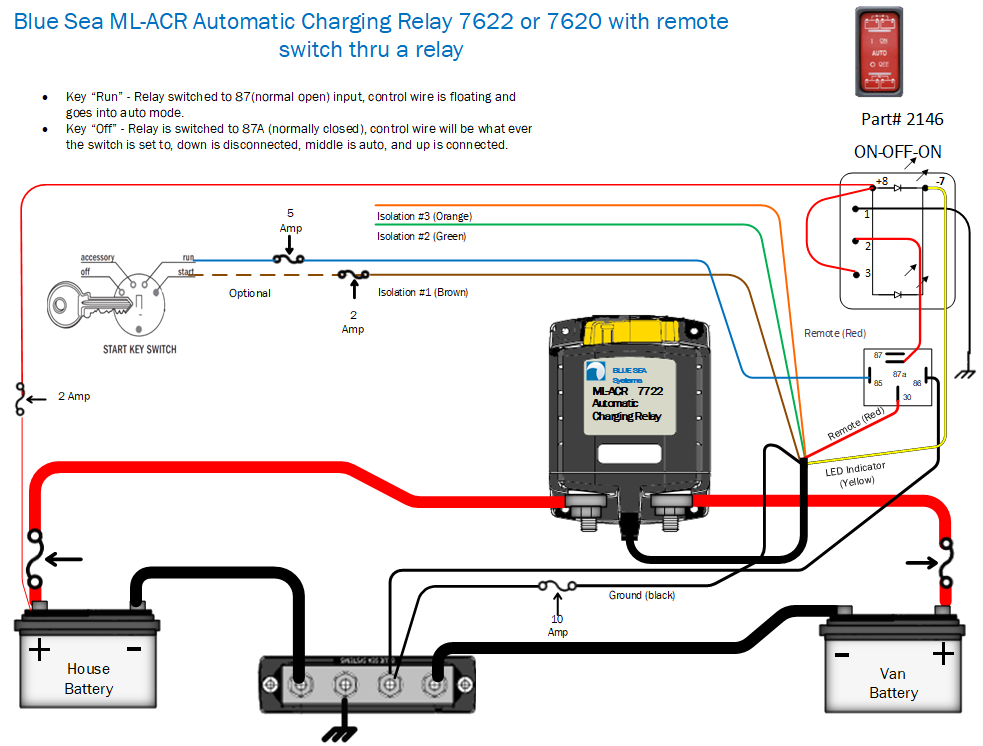 Fusing
Fusing
There are two places for fusing, the first would be to fuse the wires from the two battery systems. This is optional, but highly recommended. In all cases I fuse the ground connection of the unit. While fusing the ground may sound funny there is nothing wrong with it and it is part of the current path. The power for the unit is usually derived from one of the large current terminals on the unit. Any fuse there would be too large to protect the monitoring and control circuits in the unit. By placing a fuse in their ground path, we may prevent the unit from really going up in smoke. This is important and highly recommended, especially for the Sure Power units.